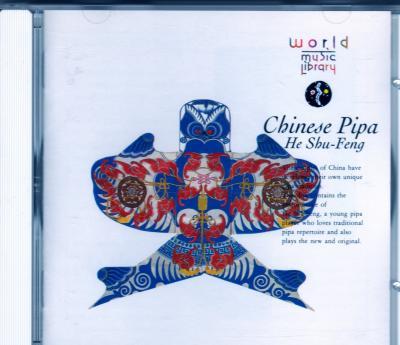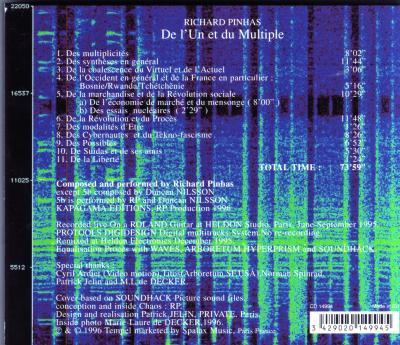
CD Inde - Ram Narayan - Concert - Sarangi Solo
O4980
En stock45,00 €
In stock
- Description
CD India masters of raga Ram Narayan sarangi solo 1994
Ram Narayan (Hindi: ??? ??????) (born December 25, 1927) is an Indian sarangi player. Narayan was educated in music from an early age and worked as an accompanist for vocalists at All India Radio since 1944. He became a concert solo artist in 1956.
Narayan’s musical career let him to be awarded Indian civilian honors and he is credited with popularizing the sarangi as a solo instrument to the extent that his name was described as “synonymous with the sarangi.”
Ram Narayan was born December 25, 1927 in Udaipur, Rajasthan[2] into a family with a musical tradition of five generations.[1] His great-great-grandfather Bagaji Biyavat was a singer from Amber, and he and Narayan’s great-grandfather sung at the court of the Maharana of Udaipur.[3] Narayan’s grandfather and his father Nathuji Biyavat were farmers and singers, and Nathuji played the dilruba.[4] Narayan’s first language was a dialect of Rajasthani,[5] and he learned Hindi and later English.[6] Narayan found a small sarangi left by the family priest[7] at an age of about six and was taught fingering technique by his father,[8] despite his father’s initial worries due to the low status of the sarangi.[4] After a year, Biyavat asked for his son to learn under sarangi player Mehboob Khan of Jaipur, but Khan required Narayan to change his technique, which his father refused.[8] Narayan’s father later encouraged his son to leave school and devote himself entirely to playing the sarangi.[7]
At about ten, Narayan learned basics of dhrupad from sarangi player Udai Lal of Udaipur by observing and imitating Lal’s practice.[8] After Lal died of old age,[9] Narayan met traveling musician Madhav Prasad, originally of Lucknow, who had performed at the court of Maihar.[10] Narayan served him and was taught khyal, but returned to Udaipur four years later and began to teach music school.[9] Prasad later visited Narayan and convinced him to vacate his position to improve as a musician,[9] but the decision to give up a secure existence for the live of a traveling musician was not well received by Narayan’s family.[10] Narayan stayed with him until Prasad died[9] in Lucknow.[11] Narayan had performed the ganda bandhan, a traditional ceremony of acceptance between a teacher and his pupil, with Prasad and another teacher who gave him a few lessons before he left for Lahore, but never had the ceremony performed again.[12]
[edit]Career
Detail of a sarangi performance
Narayan in 1944 traveled to Lahore to find work in a film studio, but was unsuccessful.[9] He instead auditioned for All India Radio (AIR) Lahore[13] as a singer, but the station’s music producer noticed grooves in Narayan’s fingernails and made him play a sarangi, upon which Narayan was employed as an accompanist for vocalists.[9] The music producer contacted khyal singer Abdul Wahid Khan, under whom Narayan learned four ragas.[9] Narayan learnt only through singing, as he had already mastered the sarangi playing technique.[14]
After the partition of India in 1947, Narayan moved to Delhi and played at the local AIR station.[15] Narayan was allowed occasional solo performances and had begun thinking of a solo career.[16] As an accompanist for vocalists, Narayan refused to stay in the background of a performance[16] to imitate the singer,[17] but instead showed his own skill.[16] Some vocalists complained he was not a consistent accompanist,[16] but Narayan maintained he wanted to keep singers in tune and inspire them in a friendly competition.[17] He accompanied Amir Khan in 1948, when Khan sang for the first time at AIR Delhi following the Indian partition.[18] Khan afterwards stopped using sarangi accompaniment because he felt distracted by the attention paid to Narayan,[19] but some other singers and tabla players publicly expressed admiration for Narayan’s playing.[20] Narayan became frustrated with his supporting role for vocalists[15] and moved to Mumbai in 1949,[15] a city with many concerts and music clubs,[21] to freelance in film music and recording.[13] To make a living, he played and composed songs in films, including Humdard, Adalat, Milan, Gunga Jumna,[22] Mughal-e-Azam, and Kashmir Ki Kali,[23] but left the film business later.[22]
Narayan’s first solo concert at a music festival in 1954 was cut short by an impatient audience that waited for a duet of Ravi Shankar and Ali Akbar Khan, and Narayan contemplated giving up the sarangi in favor of singing.[24] He later gave performances to smaller crowds and received an approving response after another attempt to play for a music festival in 1956.[24] Narayan managed to increase the sarangi’s recognition as a musical instrument[1] and gave up accompaniment in the early 1960s.[25] He started to record solo records and made his first international tour in 1964 to Europe and America.[13] Narayan frequently taught and gave concert outside of India since the 1960s.[6] In 1965, following the death of his brother Chatur Lal, Narayan struggled with alcoholism for two years, but overcame the addiction.[26] He played concert tours in India and abroad, and during the 1980s typically spent a few months each year visiting Western nations.[27] Narayan played concerts in Europe into the 2000s.[28] He resides in Mumbai,[29] is of Hindu faith,[30] and continues to perform in 2009.[31]
[edit]Contributions and recognition
NCPA Apartments
Narayan contributed to the playing of the sarangi by codifying its playing technique.[32] He uses a simplified finger technique that allows for glide (meend)[33] and influenced the contemporary sarangi concert style, as aspects of his playing and tone production were adapted by sarangi players from Narayan’s recordings.[5] For his sarangi, he exchanged gut strings for foreign harp strings to produce a clearer tone.[34] Narayan taught at Wesleyan University and Mills College, Oakland, in 1968,[35] and at the American Society for Eastern Arts and the National Centre for the Performing Arts (NCPA) in Mumbai,[13] where he also gave the first master class for sarangi.[36] Narayan privately trained sarangi players, including his only daughter and later Canadian immigrant Aruna Narayan Kalle,[37] the first female sarangi player to play a solo concert,[38] his grandson Harsh Narayan,[39] and pupils Sultan Khan[40] and Vasanti Srikhande.[41] He also taught sarod players,[42][43] including his son Brij Narayan, as well as vocalists[44][45][46] and a violinist.[47] In 2002, he had 15 Indian students and more than 500 students in the United States and Europe had studied with him.[48]
“My mission was to obliterate the blemish which the sarangi carried due to its social origins. I hope I have succeeded in this.”[49]
Ram Narayan, quoted in The Indian Express
Narayan dismissed modern Indian film music and argued recognition of him and the sarangi came after acceptance by the Western audience.[29] He attributed the lack of sarangi students to a lack of competent teachers.[29] The Pt Ram Narayan Foundation in Mumbai offers scholarships and teaches sarangi,[50] but Narayan stated he was skeptical the sarangi would survive.[51]
Narayan received the three national Padma Awards: Padma Shri in 1976, Padma Bhushan in 1991, and Padma Vibhushan in 2005.[52] The Padma Vibhushan, India’s second highest civilian honor, was awarded by Indian President Abdul Kalam.[53] Narayan was awarded the Sangeet Natak Akademi Award, the highest Indian recognition given to practicing artists,[54] in 1975,[55] the Kalidas Samman by the Government of Madhya Pradesh in 1991,[56] and the Aditya Vikram Birla Kalashikhar Puraskar, which was named in honor of Aditya Vikram Birla and awarded in 1999 by P. C. Alexander, governor of Maharashtra.[57]
[edit]
wikipedia
Produit associés
Découvrez nos autres produits et services















